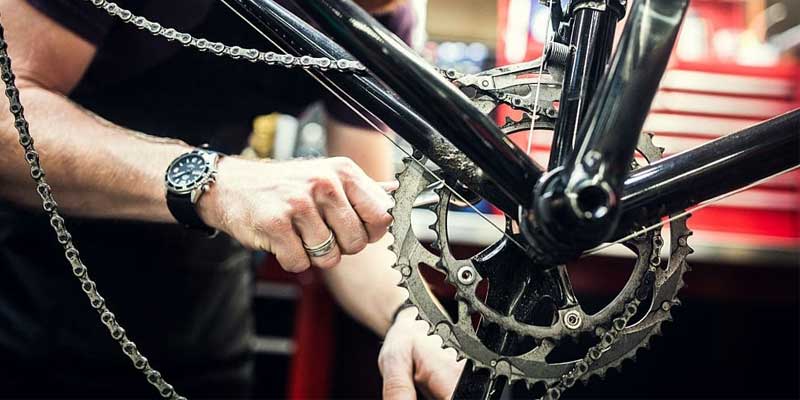A bike chain should be replaced as soon as you start to see wear. I can’t state “every x kilometres” for chain replacement because chain wear is based on many factors. It is not possible to pin down an exact number of kilometres as every cyclist ride differently. Some ride frequently, change gear too often, ride on different terrain, develop more or less wattage, etc. All of these variables are responsible for chain wear. Routine maintenance like clean/lube also plays an important role in your bike chain life. Nevertheless, you can expect your bike chain to last around 3000 to 4500 kilometres but it can be more or less in some cases.
When to replace the chain?
You should replace a bike chain when you start to see wear on the pins connecting links. It causes the chain to stretch and it does not make good contact with the gears.
If you have a bike with 10 or fewer gears on the rear wheel and your chain has stretched more than 0.75%, it’s time to replace it. Look for the stretch if it’s stretched by 1%, you should change the cassette along with the chain.
If you have a bike with 11 or more gears on the rear wheel, you need to replace the chain if it is stretched by 0.5%. Again, if it is stretched by 0.75%, replace the cassette in addition to the new chain.
If you maintain your bike properly, lube the chain frequently, and replacing it consistently at 0.5%, you can easily go through 3 chains before you need to replace the cassette.
Why and how does chain wear?
Chain wear cannot be avoided. It causes poor gear transmission and it’s less efficient at transferring your power. Chainlinks become weaker and can cause breakage.
Your chain wears in two ways i.e. flexion and stretch.
Flexion
Flexion is the lateral or sideways movement of a chain. It is often called play or slop. It is caused by wear at the contact area between the outer and the inner plates. Flexion also occurs where the pin goes through the plates. Wear is exacerbated when a chain is forced to work at angles and with derailleur gears, your chain is almost always operating at different angles. Heavier riders exert more force on their chain so they might get 2,000 kilometres usage from their chain before it needs replacing whilst lighter riders may ride 3500 or 4500 kilometres before they need to replace their chain. That means a lighter rider is going to get an extra 1500 or 2500 kilometres worth of gear changing. So, it’s the lighter rider who’ll suffer more from chain flexion problems towards the end of the chain’s life.
Stretch
The parts of a chain that are affected by stretch are the pins, the bushes, and the rollers. As you pedal, your chain is being pulled by the front chainrings and held back by the rear cogs. It’s as if your chain is being pulled at both ends with every pedal stroke you make. It may be only a small amount of wear but this happens at every link in your chain. In a new chain, the distance between each pin is half an inch or 12.7 millimetres. If the wear at each bushing and pin is only 0.1 millimetre and you multiply that by your whole chain 108 links, and that is 10.8 millimetres and now you’ve got chain stretch. Does a bit of chain stretch really matter? Absolutely. It will start to wear out your front chainrings and your rear cogs rather quickly.
How do you measure wear?
There are several ways to measure chain wear:
Measure it with a ruler
As I mentioned earlier, the distance between each pin is 0.5 inches for the brand new chain. If this distance is more, it means the chain is worn out. Put the beginning of your tape measure in the middle of your first link to count 8 and you should get 4 inches. If you want a bit more accuracy, go twice as far as 16 links and the centre of that pin should be 8 inches.
Chain wear indicator
The chain wear indicator is an inexpensive tool also called a chain checker. This gauge does exactly what its name suggests. To measure with it, just pop it on any link and it tells you if it’s 1% or 0.75%. The trouble is, at 0.75% wear, it means your chain is already starting to chew through your clogs and your front chainrings. So, what you need to do is arrest that measurement at less than 0.75% and the tool Park CC 3.2 does exactly that. It measures 0.5%.
Measuring by eye
If you don’t have the ruler and chain wear indicator, you can measure the wear by eye. This way you are going to measure if there’s a lot of play or slop of the chain on the ring. Try pulling the chain directly off of its teeth. If you see a lot more light between the chain and the chainring, that means the chainring is worn.
Final thoughts
To sum up this article, your chain being the determining factor of wear on your drivetrain. First of all, keep your chain nice and clean on the outside so it doesn’t attract dirt. Secondly, make sure your chain is well lubricated. Thirdly, measure your chain stretch. Use a tape measure or ruler but they are not very accurate. To get accurate results, use a chain wear indicator. Finally, you can measure the wear by eye.

